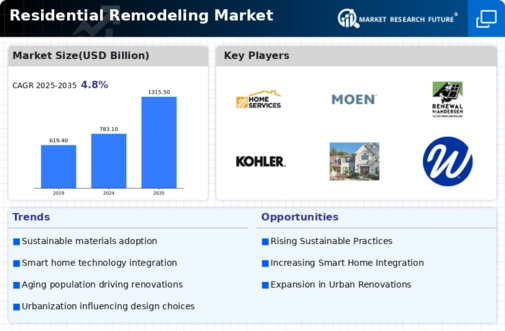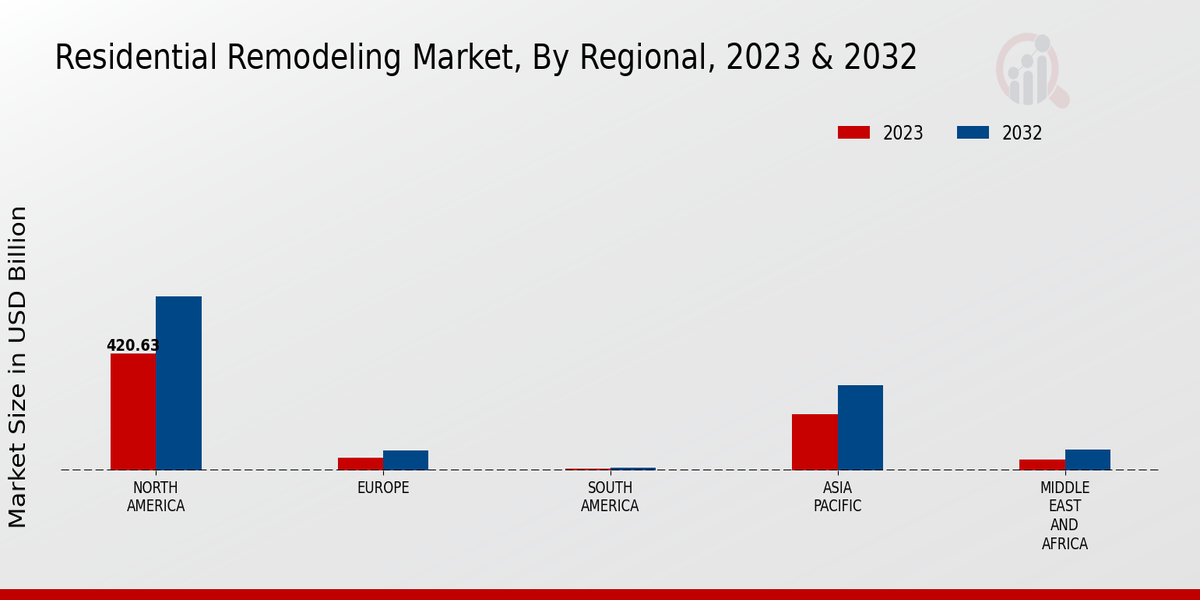Aging Housing Stock
The Global Residential Remodeling Market Industry is significantly influenced by the aging housing stock in many countries. As homes age, they require more frequent updates and repairs, leading to increased remodeling activities. In many developed nations, a substantial portion of the housing inventory is over 30 years old, which often necessitates renovations to meet modern standards and preferences. This trend is likely to drive demand for remodeling services, as homeowners seek to modernize their properties. The need for structural repairs, energy efficiency upgrades, and aesthetic improvements is expected to propel the market forward, ensuring sustained growth in the coming years.
Rising Disposable Income
The Global Residential Remodeling Market Industry is benefiting from rising disposable incomes, which enable homeowners to invest in remodeling projects. As economic conditions improve, consumers are more willing to allocate funds towards enhancing their living spaces. This trend is particularly evident in emerging markets, where a growing middle class is increasingly interested in home improvements. With projections indicating a market value of 1315.5 USD Billion by 2035, the potential for growth in remodeling services is substantial. Homeowners are likely to prioritize renovations that enhance comfort and aesthetics, further driving demand in the remodeling sector.
Technological Advancements
Technological advancements are reshaping the Global Residential Remodeling Market Industry by introducing innovative solutions that enhance efficiency and design. Smart home technologies, energy-efficient appliances, and sustainable materials are becoming increasingly popular among homeowners. These advancements not only improve the functionality of living spaces but also appeal to environmentally conscious consumers. As the market adapts to these trends, remodeling projects are likely to incorporate cutting-edge technologies, which could lead to higher project costs but also increased consumer satisfaction. The integration of technology in remodeling is expected to drive market growth, as homeowners seek to create modern, efficient living environments.
Increasing Homeownership Rates
The Global Residential Remodeling Market Industry is experiencing growth driven by rising homeownership rates across various regions. As more individuals invest in properties, the demand for remodeling services increases. For instance, in 2024, the market is valued at 783.1 USD Billion, reflecting a robust interest in enhancing living spaces. Homeowners are likely to undertake renovations to improve property value and personal comfort. This trend is particularly pronounced in urban areas where housing stock is aging, necessitating updates and repairs. As homeownership continues to rise, the remodeling sector is expected to flourish, contributing to the overall market expansion.
Shifts in Consumer Preferences
Shifts in consumer preferences are playing a pivotal role in the Global Residential Remodeling Market Industry. Homeowners are increasingly seeking personalized and functional spaces that reflect their lifestyles. This trend is evident in the growing popularity of open floor plans, multifunctional rooms, and outdoor living spaces. As consumers prioritize comfort and aesthetics, remodeling projects are becoming more tailored to individual needs. This shift is likely to encourage homeowners to invest in renovations that enhance their living environments, thereby contributing to the overall growth of the market. The demand for customized remodeling solutions is expected to remain strong in the foreseeable future.








